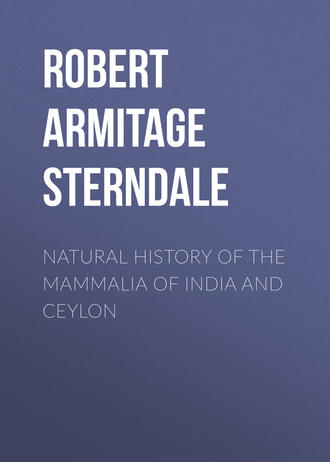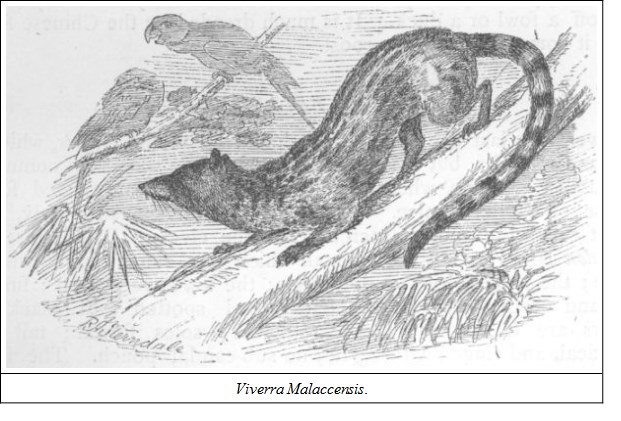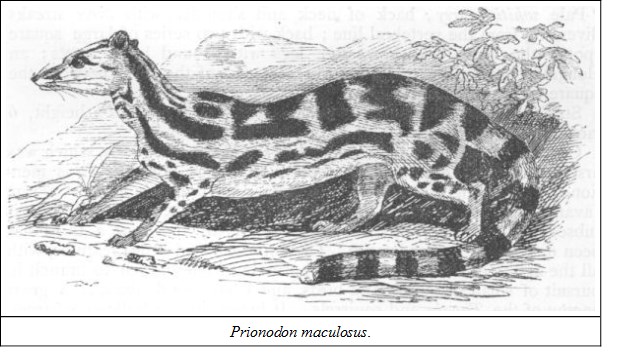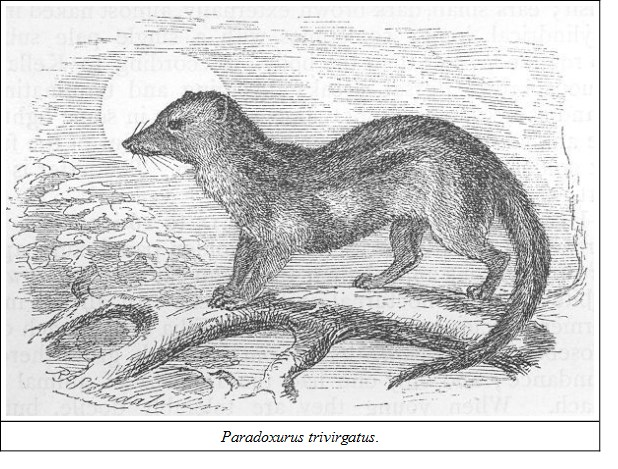 полная версия
полная версияПолная версия
Natural History of the Mammalia of India and Ceylon
SIZE.—Head and body, 33 to 36 inches; tail 13 to 20.
"This animal frequents brushwood and grass, and the thorny scrub that usually covers the bunds of tanks. It is very carnivorous and destructive to poultry, game, &c., but will also, it is said, eat fish, crabs and insects. It breeds in May and June, and has usually four or five young. Hounds, and indeed all dogs, are greatly excited by the scent of this civet, and will leave any other scent for it. It will readily take to water if hard pressed."—Jerdon.
The drug civet is usually collected from the glands of this and other species, which are confined for the purpose in cages in which they can hardly turn round, and it is scraped from the pouch with a spoon. Sometimes the animal rubs off the secretion on the walls and bars of its cage, which are then scraped; but the highest price is given for the pouch cut from the civet when killed. In the London Zoological Gardens the collection of the perfume, which is rubbed off against the walls of the cage, is a valued perquisite of the keeper. Cuvier says of a civet which was kept in captivity in Paris: "Its musky odour was always perceptible, but stronger than usual when the animal was irritated; at such times little lumps of odoriferous matter fell from its pouch. These masses were also produced when the animal was left to itself, but only at intervals of fifteen to twenty days."
NO. 222. VIVERRA CIVETTINAThe Malabar Civet-Cat (Jerdon's No. 120)HABITAT.—Throughout the Malabar coast, abundant in Travancore, and found occasionally in the uplands of Wynaad and Coorg.
DESCRIPTION.—Hair long, coarse, and of a dusky or brownish-grey, and marked with interrupted transverse bands or spots in rows, two obliquely transverse black lines on the neck; the snout, throat, and neck are white; the tail tinged with black. From the shoulders along the back a mane or crest of lengthened hair.
SIZE.—Same as last species.
This species closely resembles the African civet—only that in the latter the mane begins on the occiput. Jerdon supposes that it may be found in Ceylon, but it is not mentioned by Kellaart. It is found chiefly in forests and richly-wooded lowlands, and is stated to be very destructive to poultry. The young may, however, be reared on farinaceous food, with the addition of a little fish and raw meat; when older on flesh alone.
NO. 223. VIVERRA MEGASPILANATIVE NAME.—Khyoung-myen.
HABITAT.—Burmah, also Malayan peninsula and archipelago (?)

DESCRIPTION.—The body markings larger, blacker and fewer in number than in last species.
SIZE.—Same as last.
Blyth states that this is nearly allied to the last species, but differs from V. tangalunga of Sumatra (with which some consider it synonymous) as the latter is smaller, with a more cat-like tail, and more numerous spots. Gray says that V. tangalunga has the tail black above and ringed on the lower side.
The next species is smaller and more vermiform, with acute compressed claws, a shorter tail, and no crest, and of more scansorial habits. It forms the sub-genus Viverricula of Hodgson, but it is not desirable to perpetuate the sub-division.
NO. 224. VIVERRA MALACCENSISThe Lesser Civet-Cat (Jerdon's No. 121)NATIVE NAMES.—Mushak-billi, Katas, Kasturi, Hindi; Gando-gaula, Gandha-gokul, Bengali; Jowadi-manjur, Mahrathi; Punagin-bek, Canarese; Punagu-pilli, Telegu; Sayer, Bug-nyul, Nepalese; Wa-young-kyoung-bank, Aracanese; Kyoung-ka-do, Burmese; Ooralawa, Singhalese.
HABITAT.—India generally, with Assam, Burmah, and Ceylon. It extends also to the Malayan countries, Java and China.

DESCRIPTION.—General colour greyish-brown, spotted black; the dorsal spots elongated, and forming longitudinal interrupted streaks or stripes on the back and croup; the sides and limbs have also spots in lines; a long black streak from ear to shoulder, and some transverse lines on the sides of the neck. Abdomen nearly spotless; feet and part of legs dusky-brown; tail long and tapering, marked with eight or nine black rings.
SIZE.—Head and body, 22 to 24 inches; tail, 16 to 17 inches.
According to Jerdon, "it lives in holes in the ground or in banks, occasionally under rocks or in dense thickets, now and then taking shelter in drains and out-houses." Hodgson says: "These animals dwell in forests or detached woods and copses, whence they wander freely into the open country by day (occasionally at least) as well as by night. They are solitary and single wanderers, even the pair seldom being seen together, and they feed promiscuously upon small animals, birds' eggs, snakes, frogs, insects, besides some fruits or roots. In the Terai a low caste of woodmen, called Mushahirs, eat the flesh." Mr. Swinhoe affirms that the Chinese also eat its flesh, and adds: "but a portion that I had cooked was so affected with the civet odour that I could not palate it." The fur is valued in China as a lining for coats, and is bought by those who cannot afford the more expensive skins. Jerdon had one which was perfectly tame; it caught rats and squirrels at times, as also sparrows and other birds. It is kept alive by the natives in India and Ceylon for the sake of the secretion. Kellaart says it is a great destroyer of poultry, and that it will enter a yard in daylight and carry off a fowl or a duck. It is much dreaded by the Chinese for the havoc it commits in the hen-roost.
GENUS PRIONODONBetween the last genus and this should come the Genets, which are not found in India, but chiefly in Africa, and one species is common in the south of Europe, where in some parts it is domesticated for the purpose of catching mice. It has rudimentary pouches only, which do not yield the musky secretion of the civets. The Linsang or Prionodon is a very cat-like animal, which was once classed with the Felidæ; the body is long and slender; the limbs very short; fur soft, close and erect, very richly coloured and spotted with black; the grinders are tubercular; claws retractile; soles furred; tail long, cylindrical, and ringed with black; no sub-caudal pouch. The female has two pectoral and two inguinal mammæ. Teeth, 38; molars, 5—5/6—6.
NO. 225. PRIONODON PARDICOLORThe Tiger Civet or Linsang (Jerdon's No. 122)NATIVE NAME.—Zik-chum, Bhotia; Suliyu, Lepcha.
HABITAT.—Nepal, Sikim.
DESCRIPTION.—"Rich orange buff or fulvous, spotted with black; the neck above with four irregular lines; the body above and on the sides with large, entire elliptic or squarish marks, eight in transverse, and seven in longitudinal series, diminishing in size on the dorsal ridge, which has an interrupted dark line, and extending outside the limbs to the digits; below entirely unspotted; tail with eight or nine nearly perfect and equal rings" (Jerdon). "Skull elongate; nose rather short, compressed; brain-case narrow in front, swollen over the ears, and contracted and produced behind; orbits, not defined behind, confluent with the temporal cavity; zygomatic arch slender; palate contracted behind" (Gray). Jerdon's description is a very good one, but it must not be taken as an accurate one, spot for spot, for the animal varies somewhat in colour. Take, for instance, a description from Gray: "Pale whitish grey; back of neck and shoulders with three streaks diverging from the vertebral line; back with two series of large square spots; the shoulders, sides, and legs with round black spots; an elongated spot on the middle of the front part of the back, between the square spots on the sides of the body."
SIZE.—Head and body, 16 inches; tail, 14 inches; height, 6 inches.
Our Indian animal is closely allied to the Malayan species, which was first described as Felis and afterwards Prionodon gracilis. It is mentioned in the English translation of Cuvier as the delundung, "a rare Javanese animal, of which there is only one species," but another was subsequently found by Mr. Hodgson in Nepal, and now a third has been discovered in Tenasserim. They are beautiful little creatures, with all the agility of cats, climbing and springing from branch to branch in pursuit of small mammals and birds, and I have no doubt it is a great enemy of the Tupaiæ and squirrels. It breeds in the hollows of trees. It is capable of being tamed, and according to several authors becomes very gentle and fond of being noticed.
Hodgson says it never utters any kind of sound. He fed his on raw meat.
NO. 226. PRIONODON MACULOSUSThe Spotted LinsangHABITAT.—Tenasserim.

DESCRIPTION.—"Upper part brownish-black, broken up by greyish-white bands, lower parts white; tail brownish-black, with seven white rings; tips whitish; two broad black bands run down each side of the upper part of the neck, between them is a narrow greyish-white band with a faint mesial dark streak somewhat interrupted, and passing into two bands of elongate spots between the shoulders. The two broad dark bands pass into the dark patches on the back; on each side of these bands is a white rather wavy stripe, commencing at the ear, and continued along the neck above the shoulder and down the side to the thighs, becoming more irregular behind; below this again is a dark band somewhat broken up into spots in front, passing over the shoulder and continued as a line of large spots along the side. The back is chiefly brownish-black, crossed by six narrow transverse whitish bands, the first five equidistant, the foremost communicating with the mesial neck band, and the hinder all uniting with the white band on the side, so as to break up the dark colour into large spots. There are small spots on the fore neck, lower portion of the sides, and outside of the limbs, the spots in the neck forming an imperfect gorget. The white rings on the tail are not much more than half the breadth of the dark rings; the last ring near the tip and the first white ring are narrower than the others; nose dark brown mixed with grey; a dark ring round each orbit, with a streak running back to below the ear, and another passing up to the crown; forehead between and behind the eyes and in front of the ears and cheeks pale grey; ears rounded and clad with blackish hairs outside and near the margin inside, a few long pale hairs on the inner surface of the ear conch; whiskers long, extending to behind the ears, the upper brown, the lower entirely white; soles, except the pads, which are naked, covered with fine hair." The above careful description is by Mr. W. T. Blanford on specimens collected by Mr. Davison in Burmah. Mr. Davison lately showed me a beautiful specimen, which I should describe by a reverse process to Mr. Blanford's, taking the light colour as the ground work, and stating it to be of a yellowish-white or pale buff, with broad black bands and blotches as above described, or in general terms broad black patches over the back, two longitudinal interrupted black bands along the neck and sides, with two lines of elongated spots above and below the lower band, and numerous small spots on the throat, chest and limbs.
SIZE.—Head and body, 18¼ inches; tail, 16 inches without the hair, 16¾ with it.
This is a larger animal than P. pardicolor, and is distinguished from it by its larger marking. The fur is beautifully soft and close. From the richness of its colouring, the elegance of its shape, and the agility of its movements, it is one of the most beautiful and interesting of our smaller mammals.
NO. 227. PRIONODON GRACILISThe Malayan LinsangHABITAT.—Malacca, Siam, Sumatra, and Tenasserim.
DESCRIPTION.—Fur white, back with broad black cross-bands, sides of neck with a broad black streak continued along the sides of the body, confluent with the bands of the neck; back of neck with five parallel black streaks; tail with seven black and white streaks; a second streak, broken into spots, from the side of the neck to the haunches; legs with small black spots.
Very similar to the last, only somewhat smaller.
Between Prionodon and the next comes a genus Hemigalea, which contains one species, H. Hardwickii, inhabiting the Malay countries. It is a perfect link between Prionodon and Paradoxurus.
GENUS PARADOXURUS—THE MUSANGSParadoxurus is a misnomer, signifying queer-tailed, which originated in an abnormal twist in the tail of the specimen first described and named by M. F. Cuvier. I do not think that it is even occasional, as stated by some naturalists, but is of comparatively rare occurrence; and such deformities are by no means confined to this genus only.
The tail can be rolled up towards the end, and the hair is occasionally worn off, and some have a habit of curling it sideways; but I have never seen one as described by Kellaart when speaking of the genus: "The extreme or more distant half being, when extended, turned over so that the lower side is uppermost, and the animal can roll it up spirally from above downwards, and from the extremity to the base."
In general appearance the musang resembles the civet, and it has in some species a sub-caudal glandular fold which contains a secretion, but without the musky odour of civet.
The dentition is singularly like that of the dog, save that the flesh tooth is proportionally much stouter.
The feet are five-toed, webbed; pads bald; claws semi-retractile; tail very long, with from thirty-six to thirty-eight vertebræ; the pupil of the eye is linear and erect.
NO. 228. PARADOXURUS MUSANGAThe Common Musang (Jerdon's No. 123)NATIVE NAMES.—Khatas, Menuri (in Southern India), Lakati; Jharka-kutta, Hindi; Bhonar, Bengali; Ud, Mahrathi; Kera-bek, Canarese; Manupilli, Telegu; Marra-pilli, Malayan (toddy-cat and tree-cat of Europeans); Sakrala, Khoonla.
HABITAT.—Throughout India, Burmah and Ceylon, extending to the Malay countries.
DESCRIPTION.—It is difficult to lay down any precise rule for the colour of this animal, for it varies much. In general it is a fulvous grey, marked or clouded with black, or with black longitudinal stripes. No two naturalists describe it exactly alike. The limbs are, however, always dark, and there is usually a dark stripe down from the top of head to the centre of the nose. I will quote a few descriptions by various authors: "General colour brownish-black, with some dingy yellowish stripes on each side, more or less distinct, and sometimes not noticeable. A white spot above and below each eye, and the forehead with a whitish band in some; a black line from the top of the head down the centre of the nose is generally observable. In many individuals the ground colour appears to be fulvous, with black pencilling or mixed fulvous and black; the longitudinal stripes then show dark; limbs always dark brown; some appear almost black throughout, and the young are said to be nearly all black" (Jerdon). "General colour fulvous grey, washed with black; face darker coloured, with four white spots, one above and one below each eye, the latter more conspicuous; from three to five—more or less interrupted—black lines run from shoulder to root of tail, the central one broader and more distinct than the lateral lines; some indistinct black spots on the sides and upper parts of limbs; tail nearly all black; feet black, soles bald to the heel, flesh-coloured" (Kellaart). "Nose brown in the centre, with the brown colour extending under the eyes; the spot under the eye is small and indistinct" (Gray). The last remark is reverse of what Kellaart says. The muzzle of the young animal is flesh coloured; they are said to lose their black hairs when kept long in confinement, and become generally lighter coloured.
SIZE.—Head and body about 20 to 25 inches; tail from 19 to 21 inches.
This is a very common animal in India, frequently to be found in the neighbourhood of houses, attracted no doubt by poultry, rats, mice, &c. It abounds in the suburbs of Calcutta, taking up its abode sometimes in out-houses or in secluded parts of the main building. During the years 1865-66 a pair inhabited a wooden staircase in the Lieutenant-Governor's house at Alipore (Belvedere). We used to hear them daily, and once or twice I saw them in the dusk, but failed in all my attempts to trap them. That part of the building has since been altered, so I have no doubt the confiding pair have betaken themselves to other quarters. In a large banyan-tree in my brother's garden at Alipore there is a family at the present time, the junior members of which have lately fallen victims to a greyhound, who is often on the look-out for them. As yet the old ones have had the wisdom to keep out of his way.
They are very easily tamed. I had one for a time at Seonee which had been shot at and wounded, and I was astonished to find how soon it got accustomed to my surgical operations. Whilst under treatment I fed it on eggs. In confinement it is better to accustom it to live partly on vegetable food, rice, and milk, &c., with raw meat occasionally. Its habits are nocturnal. I cannot affirm from my own experience that it is partial to the juice of the palm tree, for toddy (or tari) is unknown in the Central Provinces, and I have had no specimens alive since I have been in Bengal, but it has the character of being a toddy-drinker in those parts of India where the toddy-palms grow; and Kellaart confirms the report. It is arboreal in its habits, and climbs with great agility.
NO. 229. PARADOXURUS (PAGUMA of Gray) GRAYIIThe Hill Musang (Jerdon's No. 124)HABITAT.—South-east Himalayas and Burmah, from Nepal to Arakan.
DESCRIPTION.—"Colour above light unspotted fulvous brown, showing in certain lights a strong cinereous tinge, owing to the black tips of many of the hairs; beneath lighter and more cinereous; limbs ash-coloured, deeper in intensity towards the feet, which are black; tail of the same colour as the body, the end dark, white-tipped; ears rounded, hairy, black; face black, except the forehead; a longitudinal streak down the middle of the nose, and a short oblique band under each of the eyes, which are gray or whitish."—Jerdon.
SIZE.—Head and body, 30 inches; tail, 20 inches.
According to Hodgson, this species keeps to the forests and mountains, feeding on small animals and birds, and also vegetable food. "One shot had only seeds, leaves, and unhusked rice in its stomach. A caged animal was fed on boiled rice and fruits, which it preferred to animal food. When set at liberty it would lie waiting in the grass for mynas and sparrows, springing upon them from the cover like a cat, and when sparrows, as it frequently happened, ventured into its cage to steal the boiled rice, it would feign sleep, retire into a corner, and dart on them with unerring aim. It preferred birds, thus taken by itself, to all other food.
"This animal was very cleanly, nor did its body usually emit any unpleasant odour, though when it was irritated it exhaled a most foetid stench, caused by the discharge of a thin yellow fluid from four pores, two of which are placed on each side of the intestinal aperture."
NO. 230. PARADOXURUS BONDARThe Terai Musang (Jerdon's No. 125)NATIVE NAMES.—Chinghar, Hindi; Bondar, Baum, Bengali; Mach-abba and Malwa in the Nepal Terai.
HABITAT.—Nepal, North Behar and Terai.
DESCRIPTION.—Clear yellow, tipped with black, the fur coarse and harsh; under fur soft and woolly; legs blackish-brown outside; body without marks, but the bridge of the nose, upper lip, whiskers, broad cheek-band, ears, chin, lower jaw, and the terminal third of the tail blackish-brown; pale yellow round the eyes; snout and feet flesh-grey; nails sharp and curved. The female smaller and paler.
SIZE.—Head and body, about 22 inches; tail, 20 to 22; skull of one 4-1/5 inches, less ventricose than that of P. Grayii.
This species is found, like P. Musanga, in the vicinity of houses; it lives in hollow trees, where it also breeds. Its habits are in great measure those of the common musang, though it is probably more carnivorous; it will, however, eat fruit. Jerdon says: "It sleeps rolled up like a ball, and when angered spits like a cat. It is naturally very ferocious and unruly, but capable of domestication, if taken young. It has a keen sense of smell, but less acute hearing and vision by day than the mungooses."
NO. 231. PARADOXURUS TRIVIRGATUSThe Three-striped MusangNATIVE NAME.—Kyoung-na-ga, in Arakan.
HABITAT.—Tenasserim and the Malay countries; also Assam.

DESCRIPTION.—Fur blackish-brown, slightly silvered with pale tips; three narrow black streaks down the back; under parts dirty white; head, feet, and tail black or blackish-brown. This animal forms a separate genus of Gray, following Professor Peters' Arctogale, on account of the smallness of the teeth and the protraction of the palate.
I had a specimen of this Paradoxurus given to me early in the cold season of 1881 by Dr. W. Forsyth. I brought it home to England with me, and it is now in the Zoological Society's Gardens in Regent's Park. It was very tame when Dr. Forsyth brought it, but it became more so afterwards, and we made a great pet of it.
It used to sleep nearly all day on a bookshelf in my study, and would, if called, lazily look up, yawn, and then come down to be petted, after which it would spring up again into its retreat. At night it was very active, especially in bounding from branch to branch of a tree which I had cut down and placed in the room in which it was locked up every evening. Its wonderful agility on ropes was greatly noticed on board ship. Its favourite food was plantains, and it was also very fond of milk. At night I used to give it a little meat, but not much; but most kinds of fruit it seemed to like.
Its temper was a little uncertain, and it seemed to dislike natives, who at times got bitten; but it never bit any of my family, although one of my little girls used to catch hold of it by the forepaws and dance it about like a kitten. Its carnivorous nature showed itself one day by its pouncing upon a tame pigeon. The bird was rescued, and is alive still, but it was severely mauled before I could rescue it, having been seized by the neck.
NO. 232. PARADOXURUS LEUCOTISThe White-eared MusangNATIVE NAME.—Na-zwet-phyoo, Arakanese.
HABITAT.—Burmah and Assam.
DESCRIPTION.—Fur longish, soft, and silky; upper parts tawny; reddish-brown on back and sides; thighs, legs, throat, and belly lighter; tail long, deep chestnut brown; nose with a central white line; ears yellowish.
NO. 233. PARADOXURUS ZEYLANICUSThe Golden MusangNATIVE NAME.—Coolla-weddah, Singhalese.
HABITAT.—Ceylon.
DESCRIPTION.—A golden-brown colour arising from the longer hairs having a bright golden tint; the shorter hairs brown, paler beneath; head and legs dark brown; muzzle and lips blackish; whiskers white or yellowish; ears small, dark brown externally, almost naked internally; tail sub-cylindrical, long; sometimes with a single pale sub-terminal band; tip rounded, paler than the body. According to Kellaart, three inconspicuous brown dorsal streaks diverging and terminating on the crupper, and some very indistinct spots seen only in some lights. Gray says these animals differ in the intensity of the colour of the fur—some are bright golden and others much more brown. The latter is P. fuscus of Kellaart.
SIZE.—Head and body, 19 inches; tail, 15 to 16 inches.
Kellaart writes of this species: "The golden paradoxure appears to be a more frugivorous animal than the palm-cat (Paradoxurus typus17). Their habits are alike nocturnal and arboreal. In all the individuals of the former species examined at Newera-Ellia the stomach contained Cape gooseberries (Physalis Peruviana18), which grow there now in great abundance; and only one had the remains of animal matter in the stomach. When young they are tolerably docile, but as they grow up their natural ferocity returns." This seems strange, as they appear to be less carnivorous than the others.



